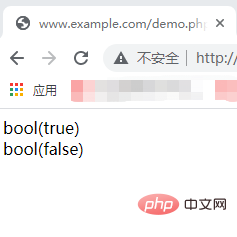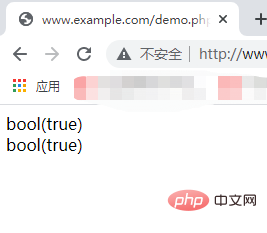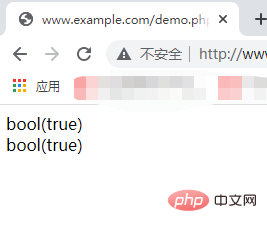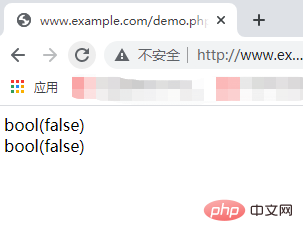How to determine whether an object belongs to a class in PHP?
In the previous article, I brought you "You must understand what abstract classes and abstract methods are in PHP", which introduced the relevant knowledge of abstract classes and abstract methods in PHP in detail. This article In this article, let’s take a look at how to determine whether an object belongs to a class in PHP. I hope it will be helpful to everyone!

In PHP, if you want to determine whether an object belongs to a class, you need to pass instanceof , and use the instanceof keyword to determine Whether an object is an instance of a class, a subclass of a class, or implements a specific interface, and performs corresponding operations. This can be used to determine whether an object belongs to a certain class. Its syntax format is as follows:
对象名 instanceof 类名;
Judge whether an object belongs to a certain class
If you want to determine whether an object belongs to a certain class, use the instanceof keyword. According to the syntax format, if the object belongs to this class, it will return true; if it does not belong to this class, it will return false.
Next, let’s take an example to see whether an object belongs to a certain class. The example is as follows:
<?php
class study{
}
class study1{
}
$obj = new study;
var_dump($obj instanceof study);
echo '<br>';
var_dump($obj instanceof study1);
?>Output result:

It can be seen from the above results that the detected object belongs to the study class and returns The result is true. The detected object does not belong to the study1 class, so false is returned. Therefore, instanceof can be used to determine whether an object belongs to a certain class.
Determine whether an object belongs to a subclass of a certain parent class
Through the above cases we have been able to determine whether an object belongs to a class Not only that, instanceof can also be used to determine whether an object inherits from a subclass of a certain parent class. Similarly, if the detected object belongs to a subclass of this parent class, the returned result is true. If the detected object If the object does not belong to a subclass of this parent class, the returned result is false.
Next let’s take a look at an example. The example is as follows:
<?php
class study{
}
class study1 extends study{
}
$obj = new study1;
var_dump($obj instanceof study);
echo '<br>';
var_dump($obj instanceof study1);
?>Output result:

By It can be seen from the above results that instanceof can also be used to determine whether an object is a subclass inherited from a certain parent class.
Determine whether an object belongs to an interface object
We can also use instanceof to determine whether a variable implements an interface The object is the same as the above. If the output result is true, it means that the object belongs to this interface. If the output result is false, it means that the object does not belong to this interface.
Let’s take a look at the example. The example is as follows:
<?php
interface study{
}
class study1 implements study{
}
$obj = new study1;
var_dump($obj instanceof study);
echo '<br>';
var_dump($obj instanceof study1);
?>Output result:

In the above example, through instanceof Determines whether a variable is an object of an interface.
When the object being judged does not exist
There is another situation we need to pay attention to. If the variable being detected is not an object, then return Will there be any changes in the results? Will there be any impact? instanceof will not report an error but will directly return flase.
Let’s take a look at the example. The example is as follows:
<?php
class study{
}
class study1{
}
$obj = new study;
var_dump($obj instanceof test);
echo '<br>';
var_dump($obj instanceof demo);
?>Output result:

As can be seen from the above example, The monitored variable is not an object, and the system does not report an error, but returns false.
If you are interested, you can click on "PHP Video Tutorial" to learn more about PHP knowledge.
The above is the detailed content of How to determine whether an object belongs to a class in PHP?. For more information, please follow other related articles on the PHP Chinese website!

Hot AI Tools

Undresser.AI Undress
AI-powered app for creating realistic nude photos

AI Clothes Remover
Online AI tool for removing clothes from photos.

Undress AI Tool
Undress images for free

Clothoff.io
AI clothes remover

Video Face Swap
Swap faces in any video effortlessly with our completely free AI face swap tool!

Hot Article

Hot Tools

Notepad++7.3.1
Easy-to-use and free code editor

SublimeText3 Chinese version
Chinese version, very easy to use

Zend Studio 13.0.1
Powerful PHP integrated development environment

Dreamweaver CS6
Visual web development tools

SublimeText3 Mac version
God-level code editing software (SublimeText3)

Hot Topics
 1664
1664
 14
14
 1423
1423
 52
52
 1317
1317
 25
25
 1268
1268
 29
29
 1246
1246
 24
24
 Explain JSON Web Tokens (JWT) and their use case in PHP APIs.
Apr 05, 2025 am 12:04 AM
Explain JSON Web Tokens (JWT) and their use case in PHP APIs.
Apr 05, 2025 am 12:04 AM
JWT is an open standard based on JSON, used to securely transmit information between parties, mainly for identity authentication and information exchange. 1. JWT consists of three parts: Header, Payload and Signature. 2. The working principle of JWT includes three steps: generating JWT, verifying JWT and parsing Payload. 3. When using JWT for authentication in PHP, JWT can be generated and verified, and user role and permission information can be included in advanced usage. 4. Common errors include signature verification failure, token expiration, and payload oversized. Debugging skills include using debugging tools and logging. 5. Performance optimization and best practices include using appropriate signature algorithms, setting validity periods reasonably,
 PHP Program to Count Vowels in a String
Feb 07, 2025 pm 12:12 PM
PHP Program to Count Vowels in a String
Feb 07, 2025 pm 12:12 PM
A string is a sequence of characters, including letters, numbers, and symbols. This tutorial will learn how to calculate the number of vowels in a given string in PHP using different methods. The vowels in English are a, e, i, o, u, and they can be uppercase or lowercase. What is a vowel? Vowels are alphabetic characters that represent a specific pronunciation. There are five vowels in English, including uppercase and lowercase: a, e, i, o, u Example 1 Input: String = "Tutorialspoint" Output: 6 explain The vowels in the string "Tutorialspoint" are u, o, i, a, o, i. There are 6 yuan in total
 Explain late static binding in PHP (static::).
Apr 03, 2025 am 12:04 AM
Explain late static binding in PHP (static::).
Apr 03, 2025 am 12:04 AM
Static binding (static::) implements late static binding (LSB) in PHP, allowing calling classes to be referenced in static contexts rather than defining classes. 1) The parsing process is performed at runtime, 2) Look up the call class in the inheritance relationship, 3) It may bring performance overhead.
 What are PHP magic methods (__construct, __destruct, __call, __get, __set, etc.) and provide use cases?
Apr 03, 2025 am 12:03 AM
What are PHP magic methods (__construct, __destruct, __call, __get, __set, etc.) and provide use cases?
Apr 03, 2025 am 12:03 AM
What are the magic methods of PHP? PHP's magic methods include: 1.\_\_construct, used to initialize objects; 2.\_\_destruct, used to clean up resources; 3.\_\_call, handle non-existent method calls; 4.\_\_get, implement dynamic attribute access; 5.\_\_set, implement dynamic attribute settings. These methods are automatically called in certain situations, improving code flexibility and efficiency.
 PHP and Python: Comparing Two Popular Programming Languages
Apr 14, 2025 am 12:13 AM
PHP and Python: Comparing Two Popular Programming Languages
Apr 14, 2025 am 12:13 AM
PHP and Python each have their own advantages, and choose according to project requirements. 1.PHP is suitable for web development, especially for rapid development and maintenance of websites. 2. Python is suitable for data science, machine learning and artificial intelligence, with concise syntax and suitable for beginners.
 PHP in Action: Real-World Examples and Applications
Apr 14, 2025 am 12:19 AM
PHP in Action: Real-World Examples and Applications
Apr 14, 2025 am 12:19 AM
PHP is widely used in e-commerce, content management systems and API development. 1) E-commerce: used for shopping cart function and payment processing. 2) Content management system: used for dynamic content generation and user management. 3) API development: used for RESTful API development and API security. Through performance optimization and best practices, the efficiency and maintainability of PHP applications are improved.
 PHP: A Key Language for Web Development
Apr 13, 2025 am 12:08 AM
PHP: A Key Language for Web Development
Apr 13, 2025 am 12:08 AM
PHP is a scripting language widely used on the server side, especially suitable for web development. 1.PHP can embed HTML, process HTTP requests and responses, and supports a variety of databases. 2.PHP is used to generate dynamic web content, process form data, access databases, etc., with strong community support and open source resources. 3. PHP is an interpreted language, and the execution process includes lexical analysis, grammatical analysis, compilation and execution. 4.PHP can be combined with MySQL for advanced applications such as user registration systems. 5. When debugging PHP, you can use functions such as error_reporting() and var_dump(). 6. Optimize PHP code to use caching mechanisms, optimize database queries and use built-in functions. 7
 The Enduring Relevance of PHP: Is It Still Alive?
Apr 14, 2025 am 12:12 AM
The Enduring Relevance of PHP: Is It Still Alive?
Apr 14, 2025 am 12:12 AM
PHP is still dynamic and still occupies an important position in the field of modern programming. 1) PHP's simplicity and powerful community support make it widely used in web development; 2) Its flexibility and stability make it outstanding in handling web forms, database operations and file processing; 3) PHP is constantly evolving and optimizing, suitable for beginners and experienced developers.




